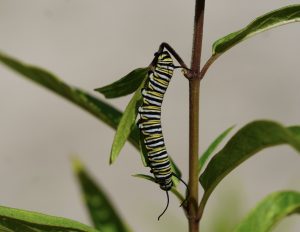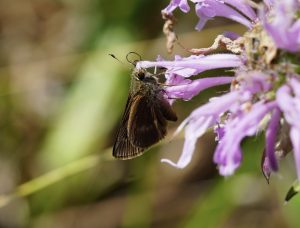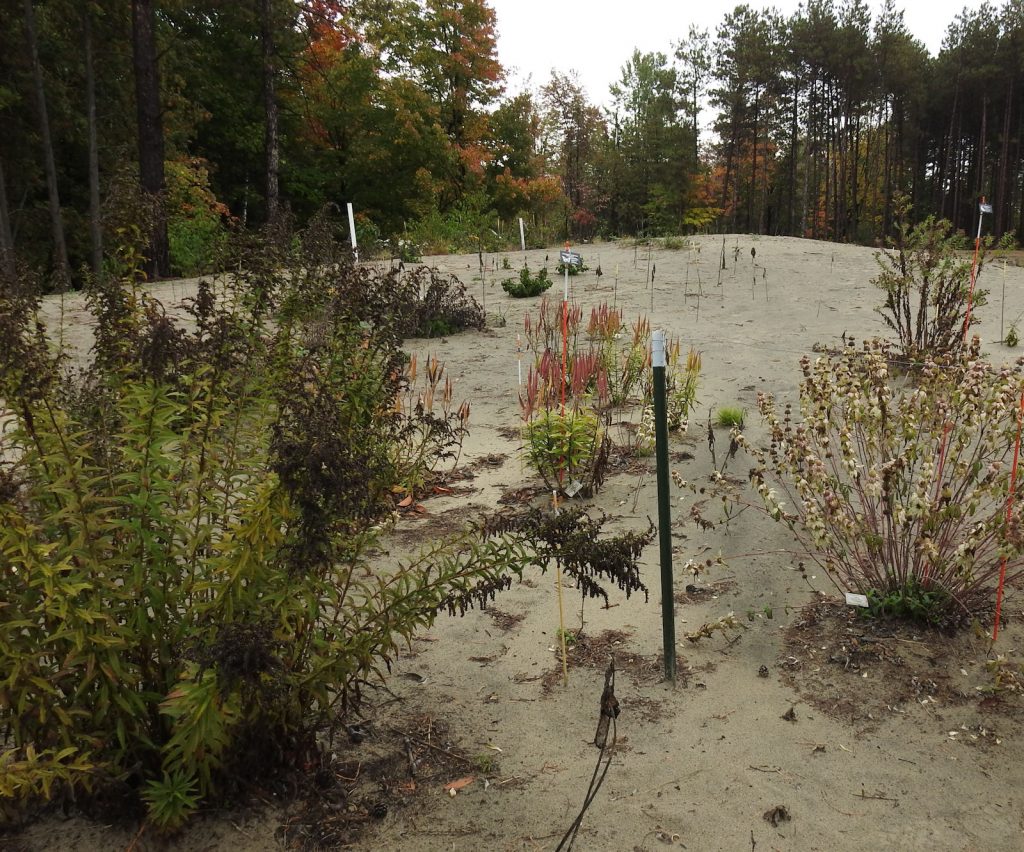by Sandy Garland, with considerable help from Berit Erickson
Our 2023 series of garden tours nearly ended in a washout. But the rain stopped and eight of us made the trip out to the Pinhey Sand Dunes on Slack Road to see a unique ecosystem and how it’s being restored.
Berit Erickson, who has been a volunteer with the project for over 4 years, hosted the tour. Her son learned about the Pinhey Sand Dunes during a science class field trip, and decided to earn his high school volunteer hours there. Instead of just dropping him off Sunday mornings, Berit stayed to help as well. She says, “Not only has it been rewarding to support habitat restoration efforts, but it has also been an opportunity to learn from entomologists and naturalists who supervise work on site.”
The Pinhey Sand Dunes, on both sides of Slack Road, are part of an inland sand dune system that formed during the last ice age when it lay beneath the Champlain Sea. According to the National Capital Commission, “The dunes provide habitat for a number of plant and animal species that can live only in sunny, exposed areas. The summer surface temperatures of the dunes range from 60°C to 72°C, and the dry, fine-grained sand measures 3-5 m deep.”
In the 1950s, trees were planted here destroying much of this rare ecosystem. However, for the past decade Biodiversity Conservancy International (BCI) has been working with the National Capital Commission to restore areas of the dunes allowing the return of its unique insect inhabitants. Restoration efforts focus on three dune remnant sites (see map), as well as a nearby hydro corridor. The tour was at site 2 (Dunes 2 on the map).
Restoring native plants to the dunes
Just as insects evolved to live in hot, dry, exposed dunes, plants did as well. Although some sand dune insects have returned to the restored areas, few native plants followed. So, in 2020 volunteers began reintroducing native plants.
Plant species were chosen from lists provided by local botanist Paul Catling, who has surveyed other sand dune remnants in our region in the past. As well as local species, some Carolinian plant species suitable for sandy habitats have also been added. Berit has been growing many of the plants for the project and supervising their establishment.

Wild Bergamot, Brown-eyed Susans, and Common Yarrow line the pathway through Dune 2, July 2023. Photo by Berit Erickson.
Butterfly sanctuary

The Hop Tree (Ptelea trifoliata) is a host for Giant Swallowtail butterflies. Photo by Sandy Garland.
Native plants not only provide food and shelter for dune insects, they also invite pollinators and encourage biodiversity. To attract human visitors, BCI is particularly interested in including host plants and nectar sources for butterflies, creating a sanctuary for these colourful insects.
Species of milkweed suitable for sandy habitats, such as Butterfly Weed and Whorled Milkweed, have been included to support Monarchs, and Swamp Milkweed has been planted in low-lying areas. Common Hoptrees have already attracted Giant Swallowtail butterflies. Various species of butterflies are often seen visiting flowers drinking nectar.
In the future, BCI plans to reintroduce the endangered Mottled Duskywing butterfly to our region at the Pinhey Sand Dunes. Local populations of this butterfly disappeared along with its host plant New Jersey Tea. Once the newly planted New Jersey Tea shrubs have matured, caterpillars can be reintroduced.
 A Monarch caterpillar eating Swamp Milkweed (Asclepias incarnata), 30 July 2023. Photo by Berit Erickson. |
 A Giant Swallowtail caterpillar feeding on Hop Tree leaves. Photo by Berit Erickson. |
 A Skipper drinking nectar from Wild Bergamot (Monards fistulosa) flowers, 22 July 2023. Photo by Berit Erickson. |
Challenges
On the tour, Berit discussed some of the challenges volunteers have faced while planting and establishing native plants at the dunes.
Over thousands of years, numerous native plant species have adapted to grow in dry, open, sandy habitats. However, the first-year seedlings Berit grew and planted at the dunes initially struggled with the site conditions. How could the survival rate be improved?
“Dig deeper,” says BCI naturalist Andrew Mott. Moist sand lies about 6 inches beneath the dry surface layer. Native plant seedlings are now grown in 4-inch deep propagation trays to encourage long roots. By planting seedlings deeply – so deep that part of their stems are even below ground level – ensures that the roots find moisture more easily. Plants have to be able to reach groundwater to survive as any rain that falls drains quickly through the deep layer of sand. The well-draining sand has so far prevented stems from rotting. Since adopting this unorthodox planting method, seedling survival has increased considerably. In the future, tall seedlings will be cut back until only 2 leaves remain – to minimize water loss through transpiration while the plants are growing roots and getting established.

Spotted Beebalm (Monarda punctata) grows well in this sandy hot environment. Large mature plants are surrounded by dozens of smaller single stems. Photo by Sandy Garland.
Watering is also an issue because there is no on-site source for supplemental watering. To water seedlings when they’re being planted, volunteers bring water in recycled plastic jugs and bottles and haul them around in wheelbarrows. Seedlings are watered generously before the planting hole is filled in. After planting, seedlings are on their own and must rely on precipitation for water.
Seedlings may also have a better chance of surviving if they’re planted in the fall. The first year seedlings will then be larger and can take advantage of the cooler, moist weather. It will also be more comfortable conditions for the people doing the planting! Planting second-year seedlings would be more successful, but would also require more babysitting before they’re planted.
Attempts at growing native plants from seeds spread on top of, or raked into the sand have been unsuccessful. If this is tried again, seeds will be covered with burlap, so they’re more likely to stay moist while still getting some sunlight. Burlap will also prevent seeds from blowing away before they become rooted.
Despite these planting tweaks, some native plant species simply refuse to grow in Dune 2. While Sundial Lupins and Whorled Milkweed grow well at Dune 3, they didn’t persist at Dune 2. Other species, like Spotted Beebalm, Black-eyed Susan, Common Yarrow, and sedges have spread vigorously. Invasive, introduced weed species also spread freely in the open setting, especially when volunteers aren’t around to pull them. The pandemic repeatedly halted work. Then, the May 2022 derecho, that downed many trees in Pinhey Forest, again prevented volunteers from working until the trees were cleared. During the summer of 2023, volunteers devoted much of their time eliminating weeds to prevent them from going to seed, and to get the native plantings back on track.

Participants in the WPP event kept to the delineated trails through the dunes, and off the planted areas. Photo by Sandy Garland.
Volunteers needed
This project needs volunteers. This summer the Ottawa Field-Naturalists’ Club organized several work sessions at the site to weed and plant seedlings.
High school and university students are welcome. Among the many jobs, sifting sand is one that requires patience but no botanical expertise. It’s a continuing effort to maintain the sandy dunes and keep out debris from the surrounding woods.
And if you’d like to help restore this amazing inland sand dune complex, please get in touch with BCI. Here’s more information about volunteering – https://www.biodiversityconservancy.org/makeadifference-html – and an email address – info@biodiversityconservancy.org.
Dr. Peter Dang, who heads BCI, is passionate about this project. Watch this 2022 video of pollinators visiting the dune and you’ll see why.




This was a very interesting read. There are lots of pointers for re-establishing a natural environment.
Thank you for this write-up of the Pinhey Sands Dunes. Very interesting.
Great article! We really enjoyed the tour and learning about volunteer opportunities with the project. Wonderful video as well. Thank you!